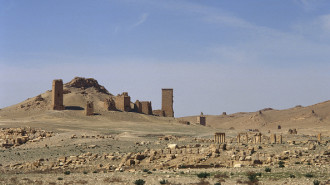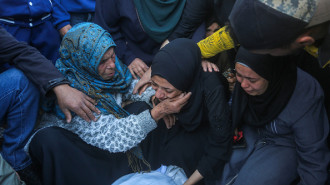Decomposed bodies, burnt homes, and smell of death everywhere: Tal al-Hawa's residents describe Israel's crimes
For seven days in a row, Mohammed Anan, a Palestinian man from the Tal al-Hawa neighbourhood, could not leave his home as Israeli tanks surrounded the street where he lives, while Israeli warplanes dropped bombs on houses nearby.
Speaking to The New Arab, the 45-year-old father of five, said, "The surprise military attack on the Tal al-Hawa neighbourhood and the industrial area did not allow me to escape with my family, especially since the tanks were stationed near the door of the building where I live. I was stuck between the jaws of death. Whether I stayed in the house or tried to escape, the army would definitely target us. I decided to stay with my family in the house no matter what happened."
Annan recalled that during the evening, the security situation became catastrophic. "The Israeli shelling did not stop for a single second, and the sounds of tanks roaming were everywhere [...] I could hear the Israeli soldiers storming houses and the neighbours screaming for help before the army opened fire and killed them," he described
"At every moment," he added, "I felt that our turn to die would inevitably come. The sounds of people I used to hear occasionally were no longer there [...] Everyone fell silent as if sleep had settled over the entire neighbourhood, while the smell of smoke dominated all the time [...] We were inhaling smoke instead of air."
Annan and his family sheltered in the living room of his flat, which was on the second floor, as a place he thought was safe, especially since it was far from the windows. It was also far from the balconies, which put them out of sight of the Israeli soldiers.
Nonetheless, the real fear for Annan was when he heard the sounds of police dogs running in the basement of the building where he lived, as if they were searching for him or any of his neighbours.
"At that precise moment, I prayed a lot and asked God to save us [...] I had difficult scenes playing out in my mind, and I did not want to see dogs tearing apart the flesh of my children in front of my eyes; I could not bear this," he remarked.
Moments, minutes, or perhaps hours, but for Anan, it felt like a lifetime of suffering. "Here, you cannot make any wise or logical decision. The Israeli army does not give us the opportunity to choose. I decided that if the army reached us, I would ask the soldiers to execute us immediately without leaving us food for the predatory dogs," he said.
Then suddenly, he no longer heard any sounds coming out from his building. It was a glimmer of hope for survival, which is what prompted him not to turn on any lights and put his mobile phone on silent, while his wife quietly tried to reach the kitchen to prepare some sandwiches for her young children.
"We remained in this state for six consecutive days until we felt that our bones had petrified from lack of movement and our tongues had frozen due to our constant silence. The smell of death was the only thing that was floating everywhere in the area," he concluded.
Mohammed al-Ashqar, a resident of the Tal al-Hawa neighbourhood, specifically near the Finance Roundabout connecting al-Sina'a Street and Abu Mazen Square, faced a similar experience. He, too, was trapped in his flat, half of which was burned during a previous Israeli attack.
"I could have fled, but I refused to be displaced again. There is no safe place for us in Gaza [...] All areas are under Israeli attacks, and we have no power or strength except to await our fate, whatever it may be, even if we die," he said to TNA.
Ashqar was forced to risk his life with 20 other members of his family and relatives, most of whom were children, as they remained in a house that barely protected them.
"We heard the sounds of armed clashes between the army and the Palestinian fighters all the time, but we could not make any sound for fear that the army would discover our presence in the house," he further described
In an attempt to document what was happening to them, Ashqar recorded the sounds of explosions, tanks, and military jeeps present in his neighbourhood from time to time, despite the danger to his life.
"All I wanted was for evidence of the crimes committed by the army to remain on my mobile phone [...] If we were killed, others could know what happened to us through my phone and the videos I documented," he remarked.
On Friday, the Israeli army withdrew from areas in Tal al-Hawa and al-Sina'a Street in Gaza City, after a week-long military assault that included ground incursions and intense shelling.
Civil defence teams headed to the areas from which the Israelis withdrew to retrieve the bodies of the dead and treat the living after it was impossible to enter those areas while the Israeli army was there.
As soon as the army withdrew, Annan and Ashqar rushed to the streets to check on their neighbours, but they were shocked by the horrific scenes. Dozens of bodies of their acquaintances were lying in the streets, some of them eaten by stray dogs, and others decomposed.
Annan told TNA that the most difficult scene he saw was my elderly neighbour from the Deeb family, who was executed by the Israeli army and was left lying in the street, where his body decomposed.
"I cried a lot for him, he encouraged me to stand firm and stay in my home and not allow the occupation to displace us [...] How did he die so easily?" he said softly.
Ashqar was also emotional when he saw the extent of the destruction left by the Israeli army in the place, which erased most of the neighbourhood.
"In the past Israeli operations, some houses were still standing, but now everything is destroyed [...] This is a clear message from the army that it does not want Gaza to return again," he said.
For its part, the Palestinian Civil Defence said that its teams were able to recover about 60 bodies of Palestinians killed by Israeli forces from the Tel al-Hawa neighbourhood and the outskirts of the al-Sabra neighbourhood in Gaza City.
The spokesman for the Civil Defence in Gaza, Mahmoud Basal, told TNA that the number of those killed in the Tal al-Hawa area and al-Sina'a Street is about 60. But this number will go higher, since, Basal noted, "dozens of martyrs' bodies were scattered in the alleys and inside homes, and entire families were martyred in al-Sina'a Street after the withdrawal of the occupation army."
Basal added that charred bodies of dead were found and houses were completely burned in Tal al-Hawa and the al-Sina'a area, stressing that the Israeli army killed citizens who went to get food supplies in the area.
The Civil Defence Service further confirmed that the Israeli army set fire to homes and facilities before withdrawing from the area, and its crews entered the area from which the occupation withdrew on foot due to the destruction of the infrastructure.
Eyewitnesses also noted that hundreds of residential units were burned or destroyed in the Tal al-Hawa neighbourhood and the al-Sina'a area by Israeli forces, while Israeli snipers are still deployed in the areas surrounding the financial roundabout in the Tal al-Hawa neighbourhood.
Before the Israeli army retreated from the area, Palestinian media also reported that the occupation forces blew up residential buildings in the Tal al-Hawa neighbourhood, southwest of Gaza City.




 Follow the Middle East's top stories in English at The New Arab on Google News
Follow the Middle East's top stories in English at The New Arab on Google News

![A group of Palestinians, foreign and Israeli activists gather to participated in an olive picking event on the land in the town of Battir, which is under threat of confiscation by Israel in Bethlehem, occupied West Bank on 8 November 2024. [Getty]](/sites/default/files/styles/image_330x185/public/2182930803.jpeg?h=199d8c1f&itok=__0LgGsa)
